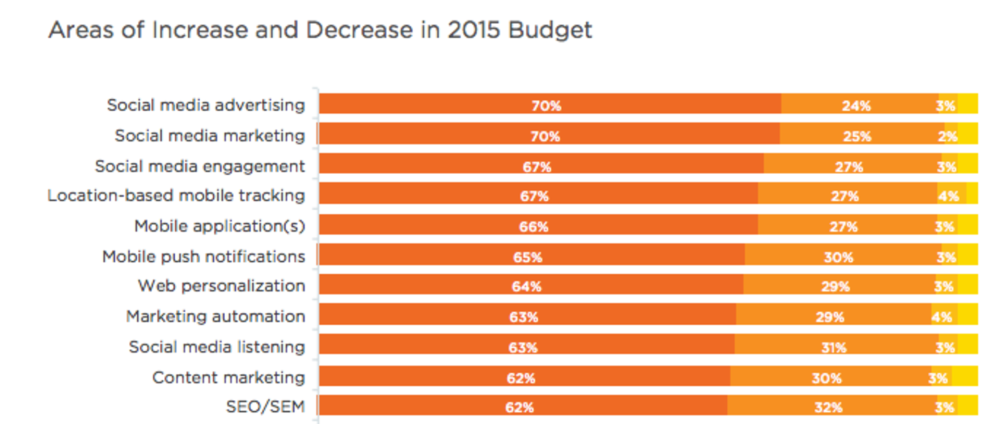In Salesforce’s recent “2015 State of Marketing” report, respondents were asked in which marketing channels they anticipated increasing budgets.
Despite all of the concerns about being squeezed out of organic reach, social media advertising led the way, with 70% of respondents saying they would increase budgets. SEO/SEM trailed significantly, at 61%, in 11th place. Some of this may be due to already high search and low social budgets, but it is an interesting development nonetheless.
While many businesses will continue to pour deep resources into search ads as a way to buy business from customers with specific and immediate intents (think home services, locksmiths, and deliveries), the reality is that the timeline to many purchases is more elongated and therefore driven from deeper customer consideration.
And when consumers are spending more time on social networks than ever before, this is the year that those sites can make a strong claim on how their ad products deserve a second look. So, in the first half of 2015, how do social ads look?
Twitter and Facebook have been on an acquisitive spree, vacuuming up data firms and ad tech companies, partnering with the biggest ad agencies and consumer data wholesalers to get beyond an awareness play.
It’s undeniable that Facebook and Twitter has strengthened how targeted their ads have gotten and how they can now track users across the social, mobile and browser web to connect the last mile of interest with actual purchases.
The jury is still out on just how much consumers will want to intermingle their social activities with purchasing – especially with commoditized products – but it will not be for a lack of trying on the social media platforms’ part.
But search will not go gently into the night. Google and Bing continue to add functionality to their sites, reminding users that it can be easier for users to find relevant information and make purchases through search than social media.
While Facebook and Twitter delve headfirst into the data-heavy, demand-generating game, Instagram and Snapchat continue to hold the line on limited, highly curated ad campaigns that focus on brand building and reach. Instagram CEO Kevin Systrom apparently looks at every ad before it runs in the ecosystem, something that is unlikely to remain tenable.
Pinterest’s Promoted Pins functionality is showing good promise, but stealth marketing campaigns may be an issue, as mentioned previously on The Hub.
Vine still does not accept ads, and brands are accustomed to working directly with content creators, many of which just use those influencers accounts for their own content, making a future ad product difficult.
And Google + gives you an opportunity to amplify your + posts on search and across the Web.
If 70% of marketers do increase their social advertising spend, there are plenty of opportunities out there. And plenty of social networks and ad technology companies to make a play for those budgets.








